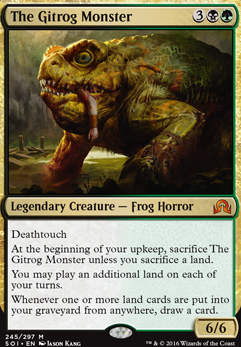Land (34)
- 1x Ancient Tomb
- 1x Bayou
- 1x Bazaar of Baghdad
- 1x Bloodstained Mire
- 1x Cavern of Souls
- 1x City of Brass
- 1x City of Traitors
- 1x Command Tower
- 1x Crystal Vein
- 1x Dakmor Salvage
- 1x Emergence Zone
- 1x Forbidden Orchard
- 1x Forest
- 1x Gaea's Cradle
- 1x Gemstone Caverns
- 1x Homeward Path
- 1x Lake of the Dead
- 1x Llanowar Wastes
- 1x Mana Confluence
- 1x Marsh Flats
- 1x Misty Rainforest
- 1x Nurturing Peatland
- 1x Overgrown Tomb
- 1x Phyrexian Tower
- 1x Polluted Delta
- 1x Prismatic Vista
- 1x Snow-Covered Forest
- 1x Snow-Covered Swamp
- 1x Swamp
- 1x Twilight Mire
- 1x Urborg, Tomb of Yawgmoth
- 1x Verdant Catacombs
- 1x Windswept Heath
- 1x Wooded Foothills
Instant (21)
- 1x Summoner's Pact
- 1x Autumn's Veil
- 1x Crop Rotation
- 1x Culling the Weak
- 1x Dark Ritual
- 1x Entomb
- 1x Fatal Push
- 1x Nature's Claim
- 1x Rain of Filth
- 1x Vampiric Tutor
- 1x Veil of Summer
- 1x Worldly Tutor
- 1x Abrupt Decay
- 1x Assassin's Trophy
- 1x Cabal Ritual
- 1x Mausoleum Secrets
- 1x Plunge into Darkness
- 1x Tainted Pact
- 1x Dismember
- 1x Force of Vigor
- 1x Ad Nauseam
Enchantment (8)
- 1x Carpet of Flowers
- 1x Wild Growth
- 1x Chains of Mephistopheles
- 1x Oblivion Crown
- 1x Squandered Resources
- 1x Survival of the Fittest
- 1x Sylvan Library
- 1x Necropotence
Artifact (8)
Commander (1)
Creature (21)
- 1x Allosaurus Shepherd
- 1x Birds of Paradise
- 1x Boreal Druid
- 1x Deathrite Shaman
- 1x Elves of Deep Shadow
- 1x Elvish Mystic
- 1x Fyndhorn Elves
- 1x Joraga Treespeaker
- 1x Llanowar Elves
- 1x Putrid Imp
- 1x Sylvan Safekeeper
- 1x Dark Confidant
- 1x Noose Constrictor
- 1x Priest of Titania
- 1x Wild Mongrel
- 1x Elvish Spirit Guide
- 1x Ramunap Excavator
- 1x Oakhame Adversary
- 1x Golgari Grave-Troll
- 1x Kozilek, Butcher of Truth
- 1x Ulamog, the Infinite Gyre
Sorcery (7)
Maybeboard
Land (5)
Sorcery (2)
Instant (1)
Enchantment (1)
Creature (2)
Suggestions
Updates Add
Comments
Attention! Complete Comment Tutorial! This annoying message will go away once you do!
Important! Formatting tips — Comment Tutorial — markdown syntax
Please login to comment
| Top Ranked |
|
| Date added | 4 years |
| Last updated | 3 years |
| Exclude colors | WUR |
| Legality | This deck is Commander / EDH legal. |
| Rarity (main - side) | 16 - 0 Mythic Rares 48 - 0 Rares 17 - 0 Uncommons 15 - 0 Commons |
| Cards | 100 |
| Avg. CMC | 1.89 |
| Tokens | Spirit 1/1 C |
| Folders | Deck References, meine, 3 Primer Reading List, z Future, cEDH primers that I play, Interesting Decks, edh, cEDH Ideas, frog, cEDH |
| Votes | |
| Ignored suggestions | |
| Shared with | |
| Views |




